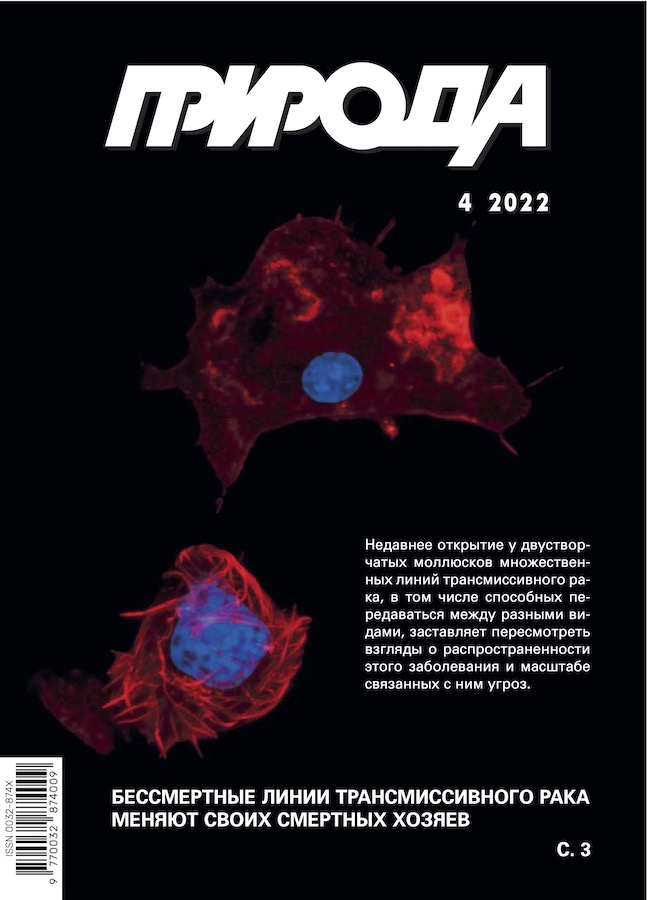Carpenter Syndrome: Immortal Lines of the Clonally Transmissible Cancer Change their Mortal Hosts
- Authors: Strelkov P.P1
-
Affiliations:
- Saint Petersburg State University
- Issue: No 4 (2022)
- Pages: 3-11
- Section: Articles
- URL: https://journals.eco-vector.com/0032-874X/article/view/627735
- DOI: https://doi.org/10.7868/S0032874X22040019
- ID: 627735
Cite item
Abstract
Clonally Transmissible Cancer (CTC) is an infectious oncological disease in which the cancer cells themselves serve as an infectious agent. An animal with CTC becomes a chimera, since the cells of its body and cancer differ in their genotypes. The CTC genotype is related to the genotype of its first animal host (in which it first appeared). The host died long ago, while its clonally dividing cancer cells continue to live like parasites. Until recently, CTC was considered a rare disease, so the hypothesis of transmissible cancer was rarely taken into account when interpreting genetic or epidemiological data. The recent discovery of multiple lineages of CTC in bivalve molluscs, including those capable of being transmitted between different species, forces the researchers to reconsider their views both on the occurrence of transmissible cancer and the scale of the associated threats. This discovery knocked the author of this article sideways, because, studying the genetics of bivalves, he had guessed about the possibilities of chimera presence, but could not find a reasonable explanation for it.
About the authors
P. P Strelkov
Saint Petersburg State University
Email: p_strelkov@yahoo.com
Saint Petersburg, Russia
References
- Novinski M.A. Zur Frage uber die Impfung der Krebsigen Geschwulste Zentralbl. Med. Wissensch. 1876; 14: 790–791.
- Murgia C., Pritchard J.K., Kim S.Y. et al. Clonal origin and evolution of a transmissible cancer. Cell. 2006; 126(3): 477–487. doi: 10.1016/j.cell.2006.05.051.
- Stammnitz M.R., Coorens T.H.H., Gori K.C. et al. The Origins and Vulnerabilities of Two Transmissible Cancers in Tasmanian Devils. Cancer Cell. 2018; 33(4): 607–619.e15. doi: 10.1016/j.ccell.2018.03.013.
- Riquet F., Simon A., Bierne N. Weird genotypes? Don’t discard them, transmissible cancer could be an explanation. Evol Appl. 2017; 10: 140–145. doi: 10.1111/eva.12439.
- Metzger M., Villalba A., Carballal M. et al. Widespread transmission of independent cancer lineages within multiple bivalve species. Nature. 2016; 534: 705–709. doi: 10.1038/nature18599.
- Caza F., Bernet E., Veyrier F.J. et al. Hemocytes released in seawater act as Trojan horses for spreading of bacterial infections in mussels. Sci. Rep. 2020; 10: 19696. doi: 10.1038/s41598-020-76677-z.
- Skazina M., Odintsova N., Maiorova M. et al. First description of a widespread Mytilus trossulus-derived bivalve transmissible cancer lineage in M.trossulus itself. Sci. Rep. 2021; 11: 5809. doi: 10.1038/s41598-021-85098-5.
- Yonemitsu M.A., Giersch R.M., Polo-Prieto M. et al. A single clonal lineage of transmissible cancer identified in two marine mussel species in South America and Europe. eLife. 2019; 8: e47788. doi: 10.7554/eLife.47788.
- Metzger M.J., Reinisch C., Sherry J., Goff S.P. Horizontal transmission of clonal cancer cells causes leukemia in soft-shell clams. Cell. 2015; 161(2): 255–263. doi: 10.1016/j.cell.2015.02.042.
- Vassilenko E.I., Muttray A.F., Schulte P.M., Baldwin S.A. Variations in p53-like cDNA sequence are correlated with mussel haemic neoplasia: A potential molecular-level tool for biomonitoring. Mutat. Res. 2010; 701(2): 145–152. doi: 10.1016/j.mrgentox.2010.06.001.
- Mackin J.G., Schlight F.G. A proteomyxan amoeba stage in the development of Labyrinthomyxa patuxent (Hogue) Mackin and Schlicht, with remarks on the relation of the Proteomyxids to the neoplastic diseases of oysters and clams. Mar. Fish. Rev. 1976; 38: 16–18.
- Metzger M.J., Paynter A.N., Siddall M.E., Goff S.P. Horizontal transfer of retrotransposons between bivalves and other aquatic species of multiple phyla. Proc. Natl. Acad. Sci. USA. 2018; 115(18): E4227–E4235. doi: 10.1073/pnas.1717227115.
- Metzger M.J., Goff S.P. A Sixth Modality of Infectious Disease: Contagious Cancer from Devils to Clams and Beyond. PLoS Pathog. 2016; 12(10): e1005904. doi: 10.1371/journal.ppat.1005904.
- Van Valen L., Maiorana V.C. HeLa, a new microbial species. Evolutionary Theory. 1991; 10: 71–74.
- Panchin A.Y., Aleoshin V.V., Panchin Y.V. From tumors to species: a SCANDAL hypothesis. Biol. Direct. 2019; 14(1): 3. doi: 10.1186/s13062-019-0233-1.
- Strakova A., Leathlobhair M.N., Wang G.D. et. al. Mitochondrial genetic diversity, selection and recombination in a canine transmissible cancer. eLife. 2016; 5: e14552. doi: 10.7554/eLife.14552.
- Siddle H.V., Kreiss A., Tovar C. et. al. Reversible epigenetic down-regulation of MHC molecules by devil facial tumour disease illustrates immune escape by a contagious cancer. Proc. Natl. Acad. Sci. USA. 2013; 110(13): 5103–5108. doi: 10.1073/pnas.1219920110.
- Hammel M., Simon A., Arbiol C. et. al. Prevalence and polymorphism of a mussel transmissible cancer in Europe. Mol. Ecol. 2022; 31(3): 736–751. doi: 10.1111/mec.16052.
- Garcia-Souto D., Bruzos A.L., Diaz S. et. al. Mitochondrial genome sequencing of marine leukaemias reveals cancer contagion between clam species in the Seas of Southern Europe. Elife. 2022; 11: e66946. doi: 10.7554/eLife.66946.
Supplementary files









